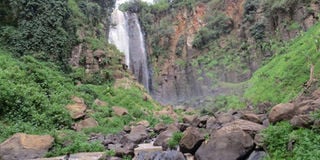TRAVEL AND LEISURE: The Legend of the Spire

Thomson's Falls. PHOTO| FILE| DAILY NATION
What you need to know:
- A tall silver spire breaks the tree line beyond the gorge of the Ewaso Nyiro River flowing from Thomson’s Falls in Nyahururu.
- The wooden pews are from the 1950s but a burst water pipe has the wooden tiled floor flooded.
- The church was built by the Indians living in Nyahururu at the time, commissioned by the Dutch who had tulips growing in the town.
- Get fit by running up and down Thomson’s Falls. Take a stroll through Nyahururu town or go birding in the grasslands and to Lake Ol Bolossat.
A tall silver spire breaks the tree line beyond the gorge of the Ewaso Nyiro River flowing from Thomson’s Falls in Nyahururu. “It’s an old church,” says Pushpa Ratna of Nyahururu Panari. Thomson’s Falls is named after Joseph Thomson, the first European to walk from the coast to Lake Victoria through central Kenya, which was deemed dangerous because of the fearsome Maasai. The myth was a ploy by slavers and ivory traders to keep outsiders away and hence have the monopoly over trade. The route Thomson mapped is today’s road from Mombasa to Lake Victoria and parts of central Kenya.

Unkept graves of the Dutch at The ACK church in Nyahururu built during the Dutch settlers time in 1953. PHOTO| FILE| NATION MEDIA GROUP

We walk in the direction of the silver spire. It looks like a magician’s pointed hat. Up close, we find out that it belongs to the African Church of Kenya (ACK). It is a handsome building with massive wooden doors and enormous knockers. We wander through the neatly kept lawns.
A young lad asks if we need assistance. We tell him we’re curious about the tall spire that’s not a usual feature. David Karanja becomes our guide. He gets the keys to open the church and leads us through the 1953 building and up a flight of stairs to the hollow spire that’s built in three layers.
“The three ladders take you to the top,” he points. We’re not allowed to climb because the ladders are for the cleaning staff. Sunlight filters through the cross, crafted from glass tiles, on the wall supporting the spire. Inside, the church is big. The wooden pews are from the 1950s but a burst water pipe has the wooden tiled floor flooded.

Young Karanja escorts us to the church’s cemetery by the woods. One side is filled with crumbling graves of the Dutch settlers from the early 1900s, inscribed in Dutch. A handsome marble tombstone with a sheen of aged patina and shaped like a book lies by the rubbish dump. Karanja shows the grave of the Dutch man responsible for the spire. “You see the statue. It has no head. When the Dutch man finished with the spire and was climbing down the ladder, he fell to the ground and his head got separated from the body.” Sad story. We can barely read his name on the tomb stone.
Anyway, Karanja then finds out that the church was built by the Indians living in Nyahururu at the time, commissioned by the Dutch who had tulips growing in the town. “This was the Asian quarter,” continues Karanja. Back then, Kenya was segregated along racial lines. “People say that there is gold hidden in the spire.” It’s probably why the story of the headless overseer is so dark – it likely keeps the spire from being vandalised.
NYAHU NEWS
Get fit by running up and down Thomson’s Falls. Take a stroll through Nyahururu town or go birding in the grasslands and to Lake Ol Bolossat, the only lake in central Kenya that’s a stronghold for the endangered Grey crowed cranes and Sharpe’s longclaw. For birding, contact George Ndung’u at [email protected]. He is the founder of the birding group in Nyahururu.

Hippo yawning at hippo pool opposite Marmanet forest and in shadows of the aberdares. PHOTO| FILE| NATION MEDIA GROUP
Nairobi to Nyahururu via Njabini is 200km. Drop in at Thomson’s Falls Lodge built in the 1930s by a struggling British man who borrowed money from his brother to complete it.




